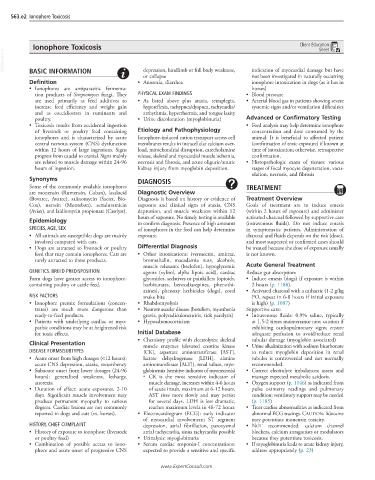Page 1129 - Cote clinical veterinary advisor dogs and cats 4th
P. 1129
563.e2 Ionophore Toxicosis
Ionophore Toxicosis Client Education
Sheet
VetBooks.ir
depression, hindlimb or full body weakness,
BASIC INFORMATION
or collapse indication of myocardial damage but have
not been investigated in naturally occurring
Definition • Anorexia, diarrhea ionophore intoxication in dogs (as it has in
• Ionophores are antiparasitic fermenta- horses)
tion products of Streptomyces fungi. They PHYSICAL EXAM FINDINGS • Blood pressure
are used primarily as feed additives to • As listed above plus ataxia, tetraplegia, • Arterial blood gas in patients showing severe
increase feed efficiency and weight gain hyporeflexia, tachypnea/dyspnea, tachycardia/ systemic signs and/or ventilation difficulties
and as coccidiostats in ruminants and arrhythmia, hyperthermia, and tongue laxity
poultry. • Urine discoloration (myoglobinuria) Advanced or Confirmatory Testing
• Toxicosis results from accidental ingestion • Feed analysis may help determine ionophore
of livestock or poultry feed containing Etiology and Pathophysiology concentration and dose consumed by the
ionophores and is characterized by acute Ionophore-induced cation transport across cell animal. It is beneficial to affected patient
central nervous system (CNS) dysfunction membranes results in intracellular calcium over- (confirmation of toxic exposure) if known at
within 12 hours of large ingestions. Signs load, mitochondrial disruption, catecholamine time of intoxication; otherwise, retrospective
progress from caudal to cranial. Signs mainly release, skeletal and myocardial muscle ischemia, confirmation.
are related to muscle damage within 24-96 necrosis and fibrosis, and acute oliguric/anuric • Histopathologic exam of tissues: various
hours of ingestion. kidney injury from myoglobin deposition. stages of focal myocyte degeneration, vacu-
olation, necrosis, and fibrosis
Synonyms DIAGNOSIS
Some of the commonly available ionophores TREATMENT
are monensin (Rumensin, Coban), lasalocid Diagnostic Overview
(Bovatec, Avatec), salinomycin (Sacox, Bio- Diagnosis is based on history or evidence of Treatment Overview
Cox), narasin (Monteban), semduramicin exposure and clinical signs of ataxia, CNS Goals of treatment are to induce emesis
(Aviax), and laidlomycin propionate (Cattlyst). depression, and muscle weakness within 12 (within 2 hours of exposure) and administer
hours of exposure. No timely testing is available activated charcoal followed by supportive care
Epidemiology to confirm diagnosis. Presence of high amounts (intravenous fluids). Do not induce emesis
SPECIES, AGE, SEX of ionophores in the feed can help determine in symptomatic patients. Administration of
• All animals are susceptible; dogs are mainly exposure. charcoal and fluids depends on the risk (dose),
involved compared with cats. and most suspected or confirmed cases should
• Dogs are attracted to livestock or poultry Differential Diagnosis be treated because the dose of exposure usually
feed that may contain ionophores. Cats are • Other intoxications: ivermectin, amitraz, is not known.
rarely attracted to these products. bromethalin, macadamia nuts, alcohols,
muscle relaxants (baclofen), hypoglycemic Acute General Treatment
GENETICS. BREED PREDISPOSITION agents (xylitol, alpha lipoic acid), cardiac Reduce gut absorption:
Farm dogs have greater access to ionophore- glycosides, sedatives or painkillers (opioids, • Induce emesis (dogs) if exposure is within
containing poultry or cattle feed. barbiturates, benzodiazepines, phenothi- 2 hours (p. 1188).
azines), phenoxy herbicides (dogs), coral • Activated charcoal with a cathartic (1-2 g/kg
RISK FACTORS snake bite PO, repeat in 6-8 hours if initial exposure
• Ionophore premix formulations (concen- • Rhabdomyolysis is high) (p. 1087)
trates) are much more dangerous than • Neuromuscular disease (botulism, myasthenia Supportive care:
ready-to-feed products. gravis, polyradiculoneuritis, tick paralysis) • Intravenous fluids: 0.9% saline, typically
• Patients with underlying cardiac or myo- • Hypoadrenocorticism at 1.5-2 times maintenance rate; caution if
pathic conditions may be at heightened risk exhibiting cardiopulmonary signs; ensure
for toxic effects. Initial Database adequate perfusion to avoid/reduce renal
• Chemistry profile with electrolytes: skeletal tubular damage (myoglobin associated)
Clinical Presentation muscle enzymes (elevated creatine kinase • Urine alkalinization with sodium bicarbonate
DISEASE FORMS/SUBTYPES [CK], aspartate aminotransferase [AST], to reduce myoglobin deposition in renal
• Acute onset from high dosages (<12 hours): lactate dehydrogenase [LDH], alanine tubules is controversial and not normally
acute CNS depression, ataxia, recumbency aminotransferase [ALT]), renal values, myo- recommended.
• Subacute onset from lower dosages (24-96 globinemia (sensitive indicator of myonecrosis) • Correct electrolyte imbalances; assess and
hours): generalized weakness, lethargy, ○ CK is the most sensitive indicator of manage expected metabolic acidosis.
anorexia muscle damage, increases within 4-6 hours • Oxygen support (p. 1146) as indicated from
• Duration of effect: acute exposures, 2-10 of acute insult, maximum at 6-12 hours. pulse oximetry readings and pulmonary
days. Significant muscle involvement may AST rises more slowly and may persist condition; ventilatory support may be needed
produce permanent myopathy to various for several days. LDH is less dramatic, (p. 1185)
degrees. Cardiac lesions are not commonly reaches maximum levels in 48-72 hours • Treat cardiac abnormalities as indicated from
reported in dogs and cats (vs. horses). • Electrocardiogram (ECG): early indicator abnormal ECG tracings. CAUTION: lidocaine
of myocardial involvement; ST segment may potentiate monensin toxicity.
HISTORY, CHIEF COMPLAINT depression, atrial fibrillation, paroxysmal • NOT recommended: calcium channel
• History of exposure to ionophore (livestock atrial tachycardia, sinus tachycardia possible blockers, calcium antagonists or modulators
or poultry feed) • Urinalysis: myoglobinuria because they potentiate toxicosis.
• Combination of possible access to iono- • Serum cardiac troponin-I concentrations: • If myoglobinuria leads to acute kidney injury,
phore and acute onset of progressive CNS expected to provide a sensitive and specific address appropriately (p. 23)
www.ExpertConsult.com

